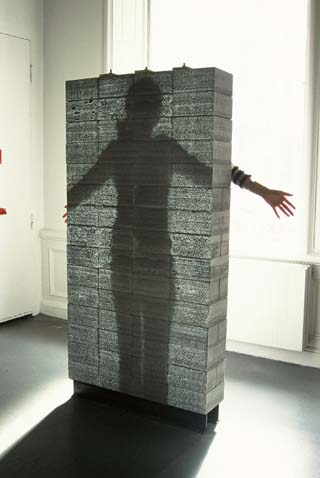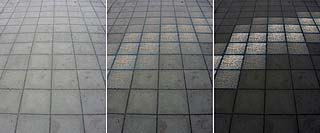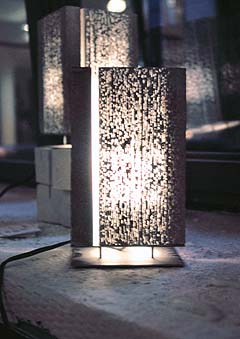|
Subscribe / Renew |
|
|
Contact Us |
|
| ► Subscribe to our Free Weekly Newsletter | |
| home | Welcome, sign in or click here to subscribe. | login |
Construction
| |
 |
June 18, 2004
Shedding a new light on the heavy stuff
LiTraCon GmbH

Photos courtesy of LiTraCon GmbH
Light transmits through optical fibers in the concrete blocks.
|
Concrete is one of the most used building materials in contemporary architecture. In the last decades, it has gone from a structural building element to a material on surfaces of buildings and public objects. Many artists have turned to concrete to create their works.
Despite its omnipresence, concrete is often considered a bulky, inhuman material.
The young Hungarian architect Áron Losonczi started to think about light-transmitting concrete after having been inspired by an artwork in his hometown. The artist experimented by embedding glass pieces of different thicknesses into a massive concrete form. The rough material gained a new quality, thanks to the filtered, spontaneously changing light coming through it.
So Losonczi invented and patented LiTraCon, a translucent concrete building block. The name LiTraCon refers to “light-transmitting concrete” and further to the interlocking of opposite conditions: light and heavy and light and dark.
LiTraCon is a combination of optical fibers and fine concrete. Thousands of fibers run side by side, transmitting light between the two main surfaces in each block. Because of their small size, the fibers blend into the concrete, becoming a component of the material like small pieces of ballast.
The result is not only having the two materials mixed, but a third, new material which is homogeneous in its inner structure and on its main surfaces as well.
In theory, a wall structure created out of LiTraCon blocks can be a couple of meters thick as the fibers work almost without any loss of light up to 20 meters!

LiTraCon inventor Áron Losonczi’s light-transmitting concrete blocks were used in a public plaza in Stockholm, Sweden. Lights below the blocks illuminate a pattern at night.
|
Moreover, the blocks are load-bearing and provide the same effect with both natural and artificial light. Glass fibers transmit light between the wall surfaces. Shadows on the lighter side will appear with sharp outlines on the darker one. Even the colors remain the same.
Such a wall acts as if a scanner and a screen with glass fiber pixels were united. This special effect creates an illusion that the wall's thickness and weight disappear.
LiTraCon blocks are made to the aesthetic and structural needs of a specific project. All sizes of precast concrete are possible: from small bricks to façade plates to paving stones that are illuminated from beneath. They can have a slight “diffuse” aesthetic or a certain grid or even a logo.
Since LiTraCon blocks are only 5 percent optical fiber, they have the same technical specifications as the concrete used to make them. Fibers can range from 2 micrometers to 2 millimeters in diameter.
Our firm, LiTraCon, can also make a special sandwich element with core insulation that doesn't lose any light transmission.

The LTC lamp, the first design object using LiTraCon technology, has been displayed at two German trade shows.
|
LiTraCon blocks are joined together through splicing or agglutinating or in conjunction with any common framework.
Losonczi's original objective is leaving its experimental prototype stage. We are testing and collecting data with the help of the Technical University Budapest, and will be able to give detailed information by year end.
Industrial production of precast LiTraCon blocks has begun. The first design object, the LTC lamp, is being shown at this year's international furniture fair in Cologne and the light+building fair in Frankfurt/Main.
After a tour through major cities in Europe, a wall made of LiTraCon blocks is now being shown at the “Liquid Stone: New Architecture in Concrete” exhibit at the National Building Museum in Washington, D.C.
Although these starting projects are small in size, they still reveal the great aesthetic and functional potential of LiTraCon.
Andreas Bittis, co-founder of LiTraCon GmbH, studied architecture, urban planning and economy at the Technical University of Aachen, Germany. He has worked as an architect on various projects and as a freelance journalist for several architectural magazines. LiTraCon GmbH is based in Aachen and Csóngrad, Hungary.
Other Stories:
- Concrete, technology are a powerful mix
- Polyester concrete — a quick fix for roadways
- Concrete struts its stuff in Washington, D.C.


